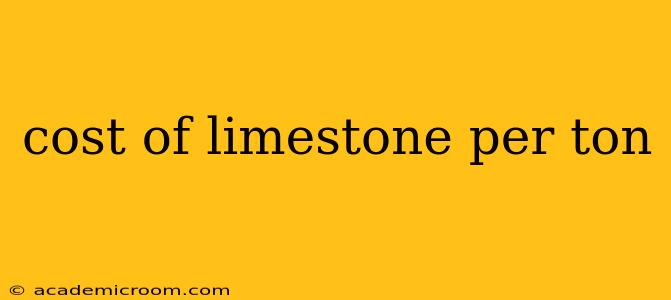Limestone, a sedimentary rock composed primarily of calcium carbonate (CaCO3), is a vital material used across numerous industries. Its cost per ton, however, varies significantly depending on several key factors. This comprehensive guide delves into these factors, providing you with a clearer understanding of what influences the price and what to expect when purchasing limestone.
What Factors Determine the Cost of Limestone Per Ton?
Several interconnected factors influence the final price you pay for a ton of limestone:
-
Location: Transportation costs significantly impact the price. Limestone quarried locally will generally be cheaper than limestone transported long distances. Regional supply and demand also play a crucial role. Areas with abundant limestone deposits may have lower prices compared to regions with limited resources.
-
Purity: The chemical composition and purity of the limestone directly affect its value. Higher purity limestone, with a lower concentration of impurities, is generally more expensive because it's suitable for a wider range of applications requiring specific chemical properties.
-
Type of Limestone: Different types of limestone possess varying physical and chemical properties. For example, high-calcium limestone, dolomitic limestone (containing significant magnesium carbonate), and high-magnesium limestone all command different prices based on their unique characteristics and suitability for specific uses.
-
Processing and Handling: The extent of processing required also affects the cost. Crushed limestone, for example, will cost more than raw, unprocessed limestone due to the additional processing steps involved. The size and shape of the limestone pieces also play a role; specialized sizes or shapes may command higher prices.
-
Market Conditions: Like any commodity, limestone prices fluctuate based on overall market demand and supply. Economic conditions, global trade, and even seasonal changes can impact pricing.
-
Quantity Purchased: Bulk purchases typically result in lower per-ton costs due to economies of scale.
What is the Average Cost of Limestone Per Ton?
Providing an exact average cost is difficult due to the fluctuating factors mentioned above. However, a rough estimate would place the price somewhere between $10 and $50 per ton. This is a wide range, and the actual cost can easily fall outside these bounds depending on the specifics outlined in the previous section.
Where Can I Find Limestone at the Best Price?
Finding the best price for limestone requires research. Contacting local quarries and suppliers directly is the best way to obtain accurate quotes for your specific needs. Online directories and industry publications can also help you locate suppliers in your area. Remember to specify the type, quantity, and desired purity level when requesting quotes to get the most accurate pricing information.
What are the Different Uses of Limestone?
Limestone's versatility is a key reason for its widespread use:
-
Construction: Limestone is used extensively in cement production, as a building material (dimension stone), and as aggregate in concrete.
-
Agriculture: It's used to adjust soil pH, improving conditions for plant growth.
-
Industry: Limestone is crucial in steelmaking, glass manufacturing, and the production of various chemicals.
What is the Difference Between Limestone and Dolomite?
Limestone and dolomite are both carbonate rocks, but they differ in their chemical composition. Limestone is primarily calcium carbonate (CaCO3), while dolomite contains significant amounts of both calcium carbonate and magnesium carbonate (CaMg(CO3)2). This difference in composition leads to variations in their properties and applications.
How is Limestone Quarried?
Limestone quarrying involves various techniques depending on the geological context and the scale of the operation. Common methods include blasting, drilling, and excavating. Modern quarrying operations prioritize minimizing environmental impact and ensuring worker safety.
In conclusion, the cost of limestone per ton is not a fixed value. By understanding the factors that influence pricing and thoroughly researching local suppliers, you can make informed decisions to obtain the best possible price for your specific project or application.
